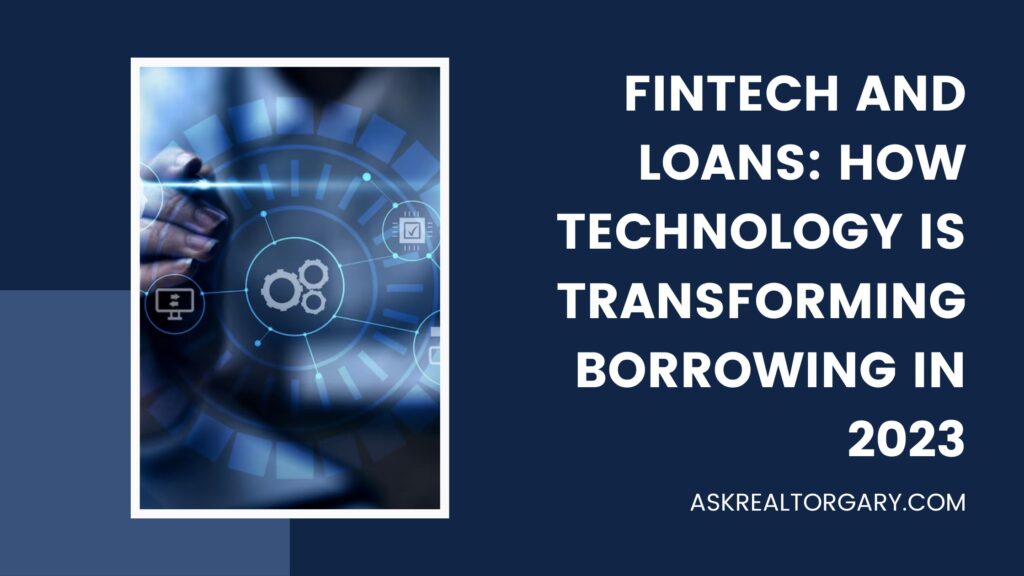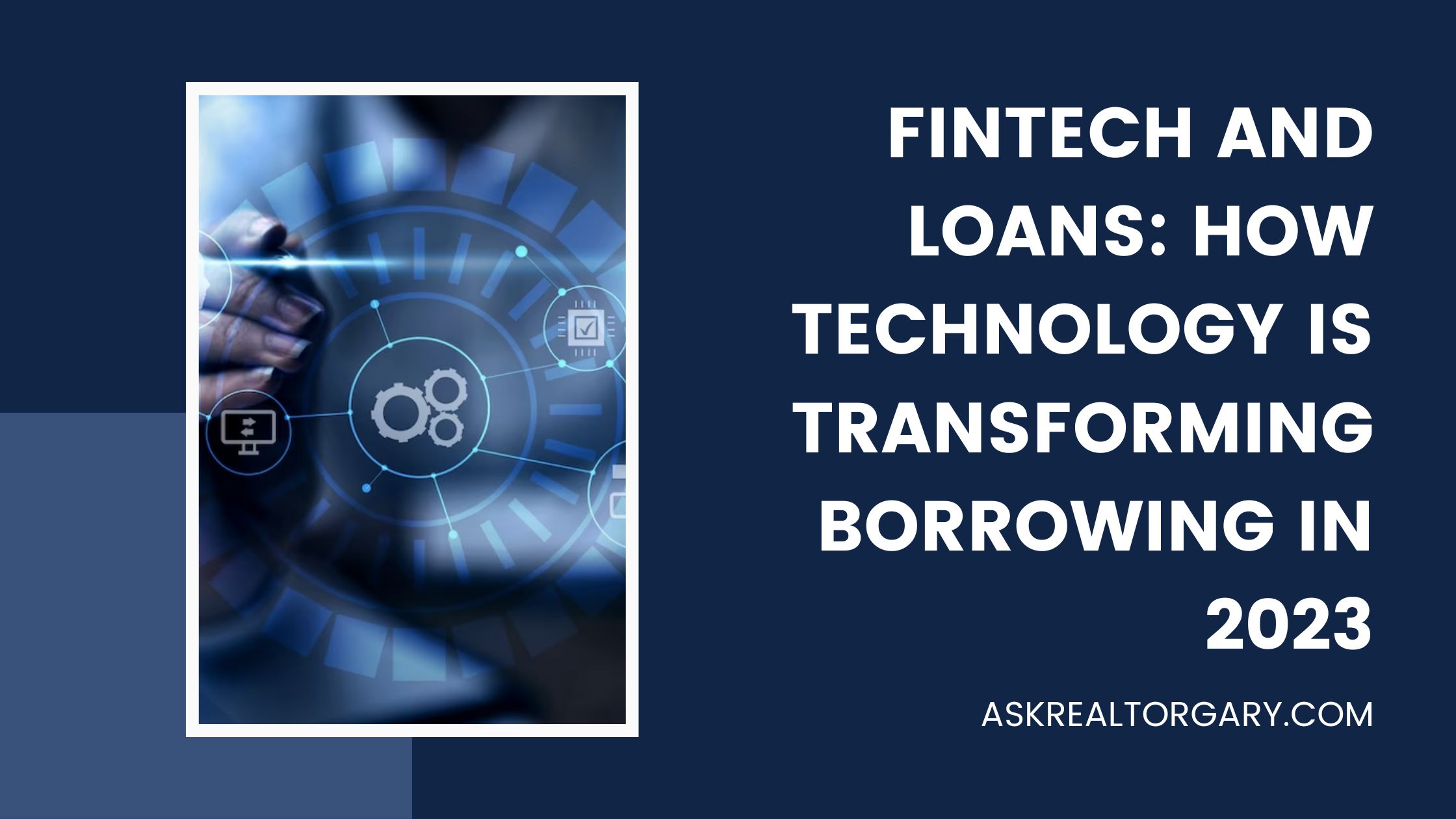In the dynamic world of finance, the year 2023 has become a turning point, where the fusion of financial technology, commonly known as fintech, and the realm of loans has forged an unbreakable bond. Over the past decade, fintech has been subtly reshaping the lending landscape, but 2023 emerges as the pivotal moment when its true potential shines. This blog post delves into the profound impact of fintech on the world of loans, exploring how technology is not just revolutionizing borrowing, but also empowering both borrowers and lenders.

The influence of fintech on loan origination is undeniable. Traditionally, obtaining a loan was synonymous with navigating a labyrinth of paperwork, enduring extensive credit checks, and battling through time-consuming verifications. Yet, with fintech’s advent, this cumbersome process has undergone a remarkable metamorphosis into a streamlined, efficient, and accessible system. Borrowers can now initiate loan applications from the comfort of their homes, eliminating the need for lengthy visits to brick-and-mortar banks.
But the fintech revolution doesn’t stop there. It delves deeper, employing advanced algorithms and artificial intelligence to completely redefine how creditworthiness is assessed. In this transformed landscape, lenders can swiftly and accurately evaluate an applicant’s financial standing, basing their credit decisions on a comprehensive analysis of financial data. This seismic shift has opened doors for individuals with previously thin credit files or unconventional income sources, as fintech algorithms now factor in a broader spectrum of financial nuances.
Contents
- 1 Fintech’s Influence on Loan Origination
- 2 Convenience and Accessibility in Loan Procurement
- 3 Key Technological Innovations Driving the Fintech Loan Revolution
- 4 Fintech and Financial Inclusion: Bridging the Gap
- 5 Security Concerns in Fintech Lending
- 6 The Future of Fintech and Loans
- 7 The Role of Machine Learning in Risk Management
- 8 The Emergence of Neobanks and Digital Challengers
- 9 Fintech and the Evolution of Credit Scoring
- 10 Fintech’s Impact on Small Business Lending
- 11 Fintech and Financial Education
- 12 Fintech’s Global Impact
- 13 Conclusion
Fintech’s Influence on Loan Origination
Fintech companies are redefining the way loans are originated. Traditionally, securing a loan involved a cumbersome process of paperwork, extensive credit checks, and time-consuming verifications. However, with fintech’s intervention, this has transformed into a streamlined and efficient system. Borrowers can now initiate loan applications online, reducing the need for physical visits to brick-and-mortar banks.
The integration of advanced algorithms and artificial intelligence has revolutionized credit assessment. Lenders can now assess an applicant’s creditworthiness swiftly and accurately, making credit decisions based on a comprehensive analysis of financial data. This has opened doors for individuals with thin credit files or unconventional income sources, as fintech algorithms consider a broader range of factors in the decision-making process.
Convenience and Accessibility in Loan Procurement
The integration of technology in the lending sector has ushered in unparalleled convenience and accessibility. Borrowers no longer need to endure lengthy queues at banks or navigate complex paperwork. Instead, they can access loans from the comfort of their homes, using their smartphones or computers. Here are some key ways in which fintech has made loans more accessible:
- Online Application Platforms: Fintech companies have developed user-friendly online platforms that allow borrowers to apply for loans quickly and conveniently. These platforms often guide applicants through the process, ensuring that all necessary information is provided.
- 24/7 Accessibility: Unlike traditional banks with limited operating hours, fintech lending platforms are accessible round the clock. This accessibility caters to the needs of a global audience, transcending geographical boundaries.
- Quick Approval and Disbursement: The integration of data analytics and automation has expedited the approval and disbursement process. In many cases, borrowers can receive funds within hours of approval, a stark contrast to the days or even weeks it used to take with traditional banks.
- Customized Loan Options: Fintech companies employ sophisticated algorithms to assess borrowers’ profiles and needs. This enables them to offer personalized loan options, including interest rates and repayment terms, catering to individual financial situations.
- Transparent Fee Structures: Fintech lenders are known for their transparent fee structures. Borrowers can easily understand the costs associated with their loans, minimizing the risk of hidden fees or unexpected charges.
Key Technological Innovations Driving the Fintech Loan Revolution
The fintech-driven transformation of the lending industry can be attributed to several technological innovations. These advancements have not only streamlined loan processes but have also enhanced the overall borrower experience. Let’s explore some of these innovations through bullet points:
- Blockchain Technology: Blockchain has introduced greater security and transparency to loan transactions. Smart contracts enable automatic execution of loan agreements, reducing the need for intermediaries and minimizing fraud.
- Artificial Intelligence (AI) and Machine Learning: AI-driven algorithms analyze vast amounts of data to assess credit risk, improving decision-making accuracy. Machine learning models continuously refine their predictions, adapting to changing borrower behaviors.
- Big Data Analytics: Fintech companies harness big data to gain deeper insights into borrower behavior and market trends. This enables them to offer tailored loan products and pricing, optimizing their competitive edge.
- Mobile Apps and Digital Wallets: Mobile apps have made it possible for borrowers to manage their loans and make payments on the go. Digital wallets offer added convenience by simplifying the disbursement and repayment processes.
- Peer-to-Peer (P2P) Lending Platforms: P2P lending platforms connect borrowers directly with individual investors, eliminating the need for traditional financial institutions. These platforms often offer competitive interest rates and flexible terms.
Fintech and Financial Inclusion: Bridging the Gap
One of the most significant societal impacts of fintech in the lending sector is its role in promoting financial inclusion. Fintech has the potential to bridge the gap between the financially underserved and access to credit. Here’s how:
Fintech lenders often use alternative data sources, such as utility bill payments and social media behavior, to assess creditworthiness. This approach enables individuals with limited or no credit history to qualify for loans. Additionally, fintech’s lower overhead costs can result in more affordable loan products, making borrowing financially viable for a wider range of people.
The convenience of fintech lending platforms also benefits those in remote or underserved areas. Traditional banks may be scarce or inaccessible in these regions, but fintech allows individuals to access financial services through the internet. Mobile banking and digital payments have the potential to revolutionize the financial landscape in developing countries, where access to traditional banking infrastructure is limited.
Security Concerns in Fintech Lending
While fintech has undoubtedly revolutionized borrowing, it has also raised concerns about security and data privacy. The digital nature of fintech lending exposes both borrowers and lenders to certain risks. It is imperative that these concerns are addressed to ensure the continued growth and stability of the fintech lending sector.
Cybersecurity: Fintech platforms are lucrative targets for cybercriminals due to the large volumes of sensitive financial data they handle. Lenders must invest in robust cybersecurity measures to safeguard customer information and prevent data breaches.
Data Privacy: Fintech companies often collect vast amounts of personal and financial data. Stricter regulations and transparent data usage policies are needed to protect consumer privacy and prevent unauthorized data sharing.
Compliance and Regulation: The evolving nature of fintech poses challenges for regulatory bodies worldwide. Striking a balance between fostering innovation and protecting consumers is crucial. Robust regulatory frameworks are necessary to ensure fair lending practices.
The Future of Fintech and Loans
As we look ahead to the future, the symbiotic relationship between fintech and loans is poised to continue evolving. Technology will continue to reshape lending practices, making them more accessible, efficient, and secure. Here are some predictions for the future of fintech lending:
- Integration of Cryptocurrencies: Cryptocurrencies may play a more prominent role in lending, offering borrowers alternative forms of collateral and payment options.
- Enhanced AI and Machine Learning: As AI and machine learning algorithms become more sophisticated, lenders will have even better tools for assessing creditworthiness and managing risk.
- Increased Regulatory Oversight: Governments and regulatory bodies are likely to play a more active role in overseeing fintech lending practices to protect consumers and maintain financial stability.
- Expansion of Financial Inclusion: Fintech’s mission to include more individuals in the financial system will continue, with a focus on reaching underserved populations globally.
The Role of Machine Learning in Risk Management
Machine learning algorithms have brought a paradigm shift to risk management in the lending industry. These algorithms can analyze vast datasets, including historical loan performance and borrower behaviors, to identify patterns and assess risk factors more accurately than traditional methods.
In 2023, lenders are increasingly relying on machine learning for real-time risk assessment. This means that as borrowers engage with their loans, machine learning models can continuously evaluate risk and adjust lending strategies accordingly. This dynamic approach enhances the lender’s ability to detect early warning signs of potential defaults, enabling them to take proactive measures such as adjusting interest rates or offering modified repayment plans to prevent delinquencies.
Moreover, machine learning-powered chatbots and customer support systems are being integrated into lending platforms to provide borrowers with personalized assistance. These chatbots can answer inquiries, offer financial advice, and even suggest suitable loan products based on the borrower’s financial profile and goals. This not only improves the borrower’s experience but also helps lenders in building long-term relationships with their customers.
The Emergence of Neobanks and Digital Challengers
Neobanks and digital challengers are redefining the banking landscape, offering consumers and businesses innovative financial services that challenge the traditional banking model. In 2023, these entities are expected to gain even more prominence, posing a significant challenge to traditional banks.
One key advantage of neobanks is their agility. They can adapt quickly to changing market conditions, offering innovative products and services that are often more aligned with customer needs. This includes seamless integration with fintech lending platforms, making it easier for consumers to access loans directly from their digital banking apps.
Additionally, neobanks typically have lower overhead costs compared to traditional banks with extensive branch networks. This cost advantage allows them to offer competitive interest rates on loans and higher yields on savings accounts, attracting customers seeking better financial terms.
However, traditional banks are not standing idly by. Many are investing in their own fintech initiatives and digital transformation to remain competitive. This competition between traditional banks and digital challengers is likely to result in an overall improvement in banking services, with consumers benefiting from a wider array of choices and more customer-centric banking experiences.
Fintech and the Evolution of Credit Scoring
Fintech has disrupted the traditional credit scoring model by broadening the criteria used to assess creditworthiness. In 2023, this evolution is more pronounced than ever, as fintech companies tap into unconventional data sources to provide a more comprehensive view of borrowers.
For instance, in addition to traditional credit bureau data, fintech lenders now consider factors like rental payment history, utility bill payments, and even social media activity. This expanded dataset helps assess the creditworthiness of individuals with limited or no credit history, often referred to as “thin-file” borrowers. As a result, more people are gaining access to credit, which can be a catalyst for improving their financial stability.
Furthermore, the use of alternative data can lead to more accurate risk assessment. Machine learning models can identify subtle patterns and correlations that may be missed by traditional scoring models. This means that borrowers with unique financial situations, such as gig workers or freelancers, are better represented and assessed fairly.
In summary, fintech’s evolution of credit scoring in 2023 is a game-changer for borrowers. It levels the playing field, reduces bias, and opens up opportunities for a wider range of individuals to access loans on more favorable terms.
Fintech’s Impact on Small Business Lending
Small businesses are the backbone of many economies, and fintech is playing a pivotal role in their growth and success. In 2023, the impact of fintech on small business lending is more evident than ever before.
Fintech lenders are known for their agility and ability to make lending decisions quickly. This is particularly advantageous for small businesses that often require prompt access to capital for various purposes, such as inventory expansion, hiring new talent, or seizing growth opportunities. Instead of navigating the bureaucratic hurdles of traditional banks, small business owners can apply for loans online and receive funds in a matter of days, if not hours.
Moreover, fintech lenders are increasingly tailoring their loan products to meet the specific needs of small businesses. This includes offering flexible repayment schedules, adjustable interest rates, and even revenue-based lending options. The result is a lending landscape that empowers small businesses to thrive and innovate.
Additionally, fintech platforms are providing valuable financial tools and resources to small business owners. From budgeting and expense tracking to financial forecasting and cash flow management, these tools help businesses make informed financial decisions and achieve long-term sustainability.
Fintech and Financial Education
Financial literacy is a critical aspect of personal financial well-being, and fintech is playing an active role in educating consumers. In 2023, fintech platforms are going beyond lending and transactions to provide valuable financial education resources.
Many fintech apps and websites include educational content such as articles, videos, and interactive tools. These resources cover a wide range of topics, from basic budgeting and saving strategies to more advanced investment and retirement planning. For users, this means that they can access financial advice and information within the same platforms where they manage their finances, promoting better financial decision-making.
Some fintech companies have also incorporated gamification elements into their apps. This makes learning about finance more engaging and enjoyable, encouraging users to explore and understand financial concepts in a user-friendly and interactive manner.
Furthermore, fintech platforms are increasingly offering personalized financial recommendations based on users’ financial habits and goals. This personalized guidance can help individuals make informed decisions about saving, investing, and managing debt.
As financial education continues to be a focal point of fintech development, consumers can expect to see even more accessible and engaging resources at their fingertips, ultimately empowering them to achieve their financial aspirations.
Fintech’s Global Impact
Fintech is a global force that transcends geographical boundaries, making financial services more accessible to people around the world. In 2023, we are witnessing fintech’s global impact on an unprecedented scale.
Cross-border lending and payments are becoming increasingly seamless thanks to fintech solutions. International money transfers that once took days and incurred hefty fees can now be executed within seconds at a fraction of the cost. This is particularly beneficial for migrant workers who send remittances to support their families back home, as well as for businesses engaged in global trade.
Moreover, fintech is addressing financial inclusion challenges in developing countries. In regions where traditional banking infrastructure is limited, mobile banking and digital payment solutions are stepping in to provide essential financial services. For example, farmers in remote areas can access microloans via mobile apps to invest in their agricultural activities, and individuals can save money securely using digital wallets.

Fintech’s global impact extends to investment opportunities as well. Peer-to-peer lending platforms connect investors with borrowers from different parts of the world, diversifying investment portfolios and opening up new avenues for earning returns.
As fintech continues to bridge gaps and break down barriers, we can anticipate more financial empowerment, economic growth, and global financial interconnectedness in the years to come.
Conclusion
In conclusion, 2023 marks a pivotal moment in the ongoing fintech revolution. The marriage of technology and lending has transformed borrowing into a more accessible, convenient, and inclusive process. While challenges remain, the potential for positive change in the financial industry is vast. As fintech continues to advance, it promises to reshape the way we access and manage loans, creating a more dynamic and inclusive financial landscape.










